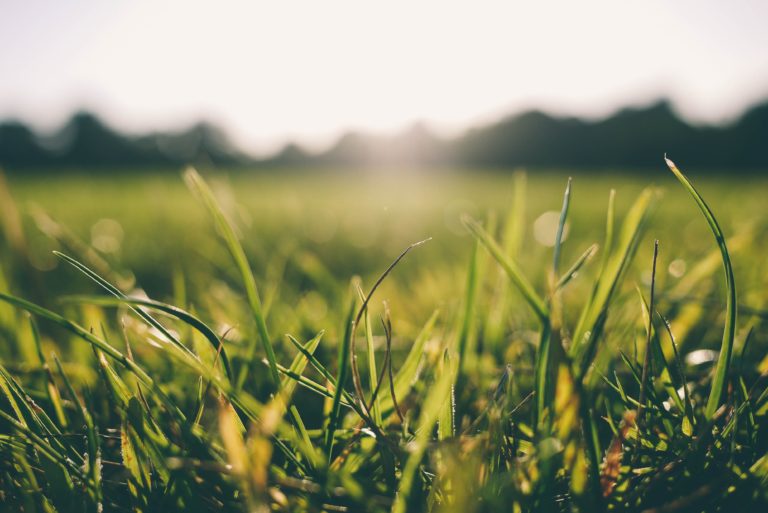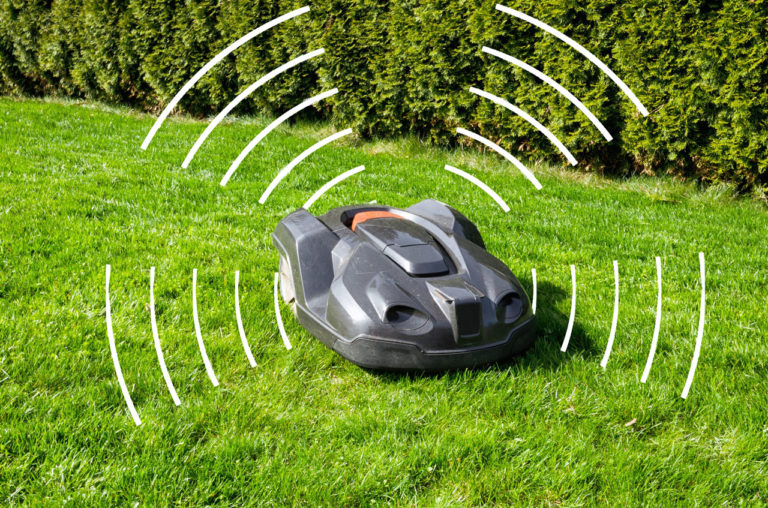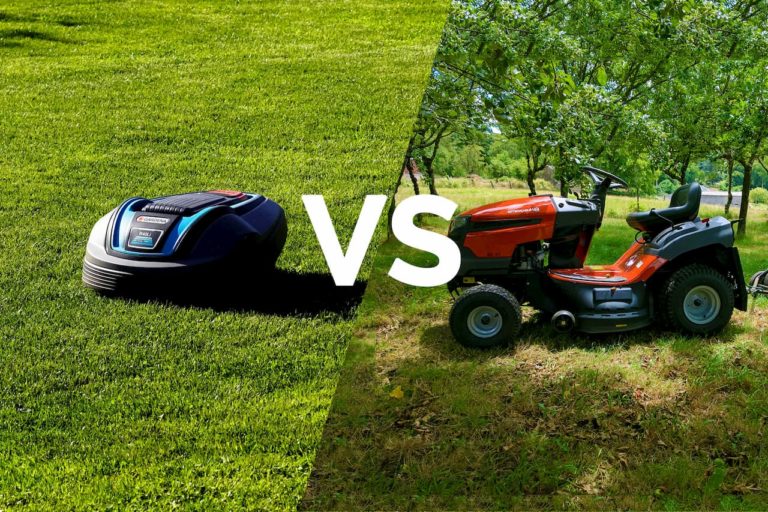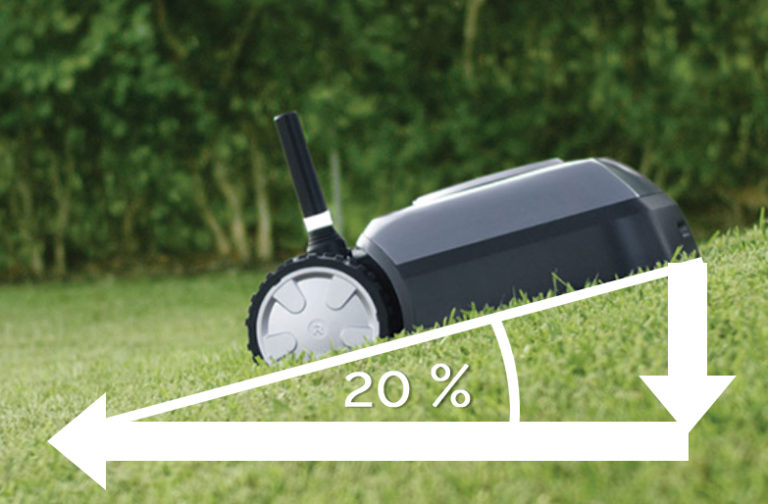You have a lawn with a rather large incline and you do not know which robotic mower is suitable for it? Here I want to show you what to look for when choosing your robotic mower, and at the same time give you an overview of the models that come into question.
How do I find the right robotic mower for slopes? When choosing the right robotic mower for slopes, the most important thing is that it is designed for the slope in question, as not all robotic mowers have the same climbing ability. Equally important is the area output, which should be chosen somewhat more generously here due to the gradient. Other factors are also taken into account, such as fallen fruit or a lot of foliage.
But what exactly are you looking for? Are the specifications of the robotic mowers correct regarding their climbing ability? What other functions do you have to look out for? I have dealt with this thoroughly in the following article.
Contents
What are the most important factors for robotic mowers on slopes?
Fitness of the robotic mower for steepness
One of the most important features of robotic mowers when steep terrains are involved is their ability to climb. Mowing robots can cope with terrain of varying steepness, depending on their design.
Virtually all robotic mowers can manage gradients of up to 25%. However, many newer models are now also designed for 35%. In the higher price segment, you will also find a number of robotic mowers that can manage 45%. Beyond that, the selection narrows significantly. Some models can achieve 50%. HUSQVARNA now has four-wheel drive models that handle an amazing 70%, but are also very expensive (Automower 435X AWD and Automower 535 AWD).
Imperative for determining the gradient that can be mastered is the strength of the engine, the weight of the robotic mower, the number of wheels (there are 3 or 4-wheeled models), and the design/material of the wheels.
Area output of the robotic mower on slopes
But the climbing ability of your mower is not the only thing that’s important. Another important factor that plays a role is the area output. This applies to all lawns, of course. The robotic mower must be designed for the size of the area. A certain amount of leeway is always important, especially since the maximum area output specification usually assumes that the robotic mower mows 12, 18, or sometimes even 24 hours a day (this depends on the manufacturer).
However, the robotic mower will probably not be on the move in your yard for 24 hours, e.g. so as not to disturb your or your neighbor’s sleep, or so that children can play safely on the lawn. Many owners program their robotic mower so that it only mows in the mornings during the week, for example, when nobody is at home, or in the evenings.
The data also assumes optimum conditions, i.e. an uncomplicated area with few bends, and grass that is easy to mow. And above all, it also assumes only very slight inclines.
On steep surfaces, the robotic mower has to use considerably more energy and also slows down somewhat when it has to drive uphill. This drains the battery more quickly and the robotic mower must return to the charging station earlier. This reduces the area output once again significantly. Unfortunately, the effect is also not compensated by driving downhill. Many robotic mowers even brake extra so that they do not drive downhill too fast.
Can I trust the information on the climbing ability?
The data on climbing ability are usually very optimistic and assume very good conditions. How well the robotic mower can actually master a slope, however, also depends on the nature of the ground.
Depending on the type of soil and the type of lawn, it may end up being more difficult for the robotic mower to climb the slope. For example, if there are a lot of leaves on the lawn, this can make it difficult for the robotic mower to climb uphill, especially if they are also wet.
In general, wet conditions can also cause difficulties, as the robotic mower can slip more easily or its wheels can spin when the ground is damp.
Many robotic mowers need a run-out zone
You must also pay attention to what the maximum gradient refers to. In most cases this means that the robotic mower drives up the slope in a straight line. But what if it has to turn while on the slope because it encounters an obstacle or the boundary wire? Then it becomes more complicated.
Most robotic mowers need an exit zone for turning. HUSQVARNA in particular makes this very clear in the instructions for its Automowers. The gradient at the boundary wire should not be too steep, but should be run a few meters with a maximum gradient of 15%.
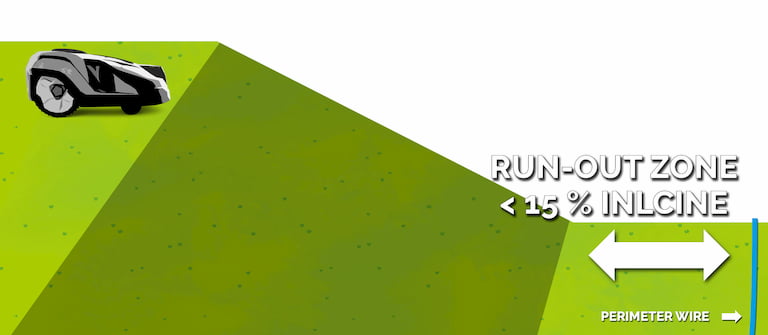
Here the robotic mower turns very often. And many robotic mowers do not get this right on steep slopes, slip down and leave massive damage to the lawn after not too long. In addition, when the robotic mower hits the cable, it must reset by a couple of inches. Many robotic mowers on steep inclines also fail to do this.
What are the differences between robotic mowers for steep slopes?
Robotic mowers try to cope with the conditions on a steep slope in different ways. They make use of the following possibilities:
- More powerful engine to cope with large inclines
- Inclination sensors, in order to be able to react to gradients by software
- Software that intelligently handles gradients
- Wheels with better traction to prevent slipping
- Number of wheels to avoid tipping over (tricycles tip over more easily)
- Rear-wheel drive vs. front-wheel drive vs. four-wheel drive. All-wheel drive can handle the steepest inclines and has fewer problems with turning and reversing
Wheels and wheel drive for coping with inclines
The robotic mower manufacturers use different wheels for their models. Mowing robots that are particularly good at coping with different terrain conditions generally have larger wheels.
In addition, some manufacturers use special wheels for their models that are able to cope with steeper gradients and are equipped with smaller cleats. This means they slip less in wet conditions and on slopes.
Some models can be retrofitted with special equipment sets, such as off-road kits or terrain kits. Most HUSQVARNA robotic mowers can be equipped with such kits.
These wheels not only have better traction due to their lugged tread pattern, but are also slightly heavier. However, they also leave slightly deeper tracks. In addition, more debris gets “stuck” on the wheels when the lawn is wet. This can be counteracted by mounting special wheel brushes, but these in turn increase the volume a little.
Another difference is the number and size of the wheels. Larger wheels are generally better able to cope with impassable terrain and help the lawn robot cope with inclines.
But more important is the difference between 3 and 4-wheeled models. 3-wheeled models have more problems with difficult terrain, especially when it comes to steep inclines. Here they can tip over more easily, for example when they are driving up a slope at an angle.
And finally, robotic mowers can be differentiated according to rear-wheel drive, front-wheel drive and all-wheel drive. As with cars, robotic mowers with four-wheel drive are more “terrain-capable”, can cope better with inclines and are also more capable of turning on slippery slopes. Mowing robots with front-wheel drive have slightly better turning technology. They are able to turn in a flowing movement while the machine is running, which can be an advantage when navigating on a boundary wire, especially on steep slopes.
An example of four-wheel drive: HUSQVARNA models that can handle up to 70% gradients (Automower 435X AWD and Automower 535 AWD) are equipped with four-wheel drive. They can also turn on slopes, as this impressive video shows.
As you can also see here, the wheels are all the same size, which of course offers a certain advantage and is due to the fact that all wheels drive the robotic mower.
I don’t know about you, but I would find it quite challenging to mow a lawn with 70 % incline with a regular mower, so the Atomower 435X AWD is quite an impressive robot.
Inclinometers and software
Robotic mowers that are designed for inclines have inclination sensors that enable them to recognize how steep the current incline is. They can make decisions based on this. How well they handle the information from the tilt sensor naturally depends on their software.
Many robotic mowers are at least smart enough to brake when they notice that they are rolling down a steep slope. But also turning and turning around at such steep places is very problematic, as I already mentioned above. So the software can also try to make intelligent decisions here that protect the lawn and prevent the robotic mower from slipping.
How smart the software is in this respect depends on the manufacturer, the model and even the software version. Software updates often bring further significant improvements. With software updates, however, the saying “if it ain’t broke, don’t fix it!” applies: If your robotic mower runs without problems, don’t make any updates, as these can also cause new problems. If, on the other hand, it has problems, e.g. in some steep places, a software update can make improvements.
What other factors are important for robotic mowers on slopes?
All other decisions you make when choosing a robotic mower ultimately affect robotic mowers on level surfaces, as well. The only thing that concerns steep areas specifically is the question of how many obstacles are in the steep part of your lawn.
If your incline is also a forest of trees, it will be especially difficult for a robotic mower to navigate, as it will constantly bump into something, be it the boundary wire that excludes a tree, or the tree itself. Even robotic mowers that are designed for such an incline may not be able to cope.
For such special cases it may be necessary to use a robotic mower with four-wheel drive.
Which models are suitable for steep terrain?
In general, some models of the brands HUSQVARNA, AMBROGIO, WIPER and HONDA are suitable for steeper gradients. Very important and often misunderstood: most robotic mowers cannot turn on steep gradients.
Here is a list of some models which can handle 45% or more gradients.
| Model | Max Raising |
|---|---|
| AMBROGIO L200 Carbon Blackline | 45 % |
| AMBROGIO L250i Elite GPS | 45 % |
| AMBROGIO L350i Elite GPS | 45 % |
| AMBROGIO L400 | 45 % |
| AMBROGIO L60 Deluxe | 45 % |
| AMBROGIO L60 Elite | 45 % |
| AMBROGIO L85 Elite | 55 % |
| HONDA Miimo HRM310 | 58 % |
| HONDA Miimo HRM520 | 58 % |
| HUSQVARNA Automower 430X | 45 % |
| HUSQVARNA Automower 430XH | 45 % |
| HUSQVARNA Automower 435X AWD | 70 % |
| HUSQVARNA Automower 450X | 45 % |
| HUSQVARNA Automower 450XH | 45 % |
| HUSQVARNA Automower 535 AWD | 70 % |
| HUSQVARNA Automower 550 | 45 % |
| HUSQVARNA Automower 550H | 45 % |
| REDBACK POWER RM24 | 50 % |
As for robotic mowers that can easily turn on steep slopes, there are only a few so far. Such a robotic mower must either have four-wheel drive or very intelligent software in combination with the right wheels, as described above.
So far I only know the two models of HUSQVARNA with four-wheel drive:
- Automower 435X AWD
- Automower 535 AWD
Related questions
How is the gradient in the lawn calculated? The gradient is usually given in percent (%), sometimes also in degrees (°). To calculate the gradient in percent, the increase in height of a specific stretch of land is divided by the length of said stretch of land. For example, if the top of the slope is 5 ft higher than the bottom, and the amount of horizontal distance covered by the slope is 20 feet, the slope is 25%.
Also interesting: Calculator for the calculation of gradients
How is degree converted into percent for gradients? To translate a gradient from degrees to percent, you need the trigonometric functions, more precisely the arc tangent. The formula for converting this is
Angle in percent = tan(angle in degrees) x 100%
